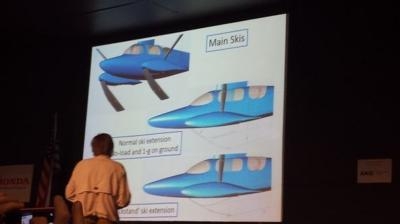Fri, Nov 06, 2015
Before An Amphibious Airplane Can Fly It Must Float, And Rutan’s New SkiGull Recently Got Its First Dip In The Water
The SkiGull is a next-generation seaplane developed by Rutan and Regan Designs. The aircraft is designed to land on a variety of surfaces (water, snow, and unimproved land), allowing access to remote areas like never before. As could be expected, it is Burt Rutan at his best designing and building an airplane for his personal use.

According to a report from the Coeur d'Alene Press, Burt Rutan, along with a group of skilled supporters, placed his SkiGull in the water for the first time and commenced with testing its water capabilities.
The report indicated that when taxiing at low speeds, the amphibian handled very well, stability was good, and the water rudder was very effective. The low-speed testing was in the range of 4 to 8 knots. However, as the taxi speed was later increased it was determined the pitch angle of the hull was too low.
It’s reported that the water taxi speeds were increased to about 18 knots and that wakes from other boats were crossed successfully, but the low pitch angle caused spray over the windshield that limited vision. While most seaplanes achieve high speed taxi stability by “running on the step,” Rutan’s design is unique in that it has retractable skis that can be extended for high speed water taxi and are intended to provide takeoff and landing capabilities in rough water conditions and other surfaces like snow and ice.

These initial taxi tests indicated that the pitch problem will have to be resolved before the skis can be used. In the article, Rutan was quoted as saying, “I was delighted with the low speed maneuverability and how easy it was to launch and recover the SkiGull. The engine started easily and ran smoothly on the Swift aviation fuel and all other systems performed as expected. As for improving the pitch trim, we have several options that we are evaluating. Overall I am very pleased with the results of our testing so far.”
In the classic Rutan style, testing challenges simply provide guidance to move in the right direction to achieve the desired outcome.
(Images from file)
More News
Airplane Bounced About 3 Ft Then Touched Back Down And Then, With No Brakes Applied, The Airplane Began Veering To The Left Analysis: The pilot entered the airport traffic pattern >[...]
Aero Linx: British Microlight Aircraft Association (BMAA) The primary focus within all aviation activity is SAFETY. In all aspects of our sport SAFETY must come first, whether it b>[...]
From SnF25 (YouTube Edition): William Wynne Builds Practical Aircraft Engines on the Corvair Platform Seeking an affordable alternative to the traditional aircraft engine options, >[...]
How To Get A Story On Aero-TV News/Feature Programming How do I submit a story idea or lead to Aero-TV? If you would like to submit a story idea or lead, please contact Jim Campbel>[...]
From 2023 (YouTube Edition): Bridge of CiES CiES Inc. is a Bend, Oregon-based designer and manufacturer of modular embedded aircraft systems and sensors. The company’s fuel-l>[...]
 NTSB Final Report: Aviat A1
NTSB Final Report: Aviat A1 ANN's Daily Aero-Linx (07.08.25)
ANN's Daily Aero-Linx (07.08.25) Classic Aero-TV: Fly Corvairs Reliable Engine Alternative
Classic Aero-TV: Fly Corvairs Reliable Engine Alternative ANN FAQ: Contributing To Aero-TV
ANN FAQ: Contributing To Aero-TV Classic Aero-TV: CiES Fuel-Quantity and e-Throttle Systems Praised
Classic Aero-TV: CiES Fuel-Quantity and e-Throttle Systems Praised




